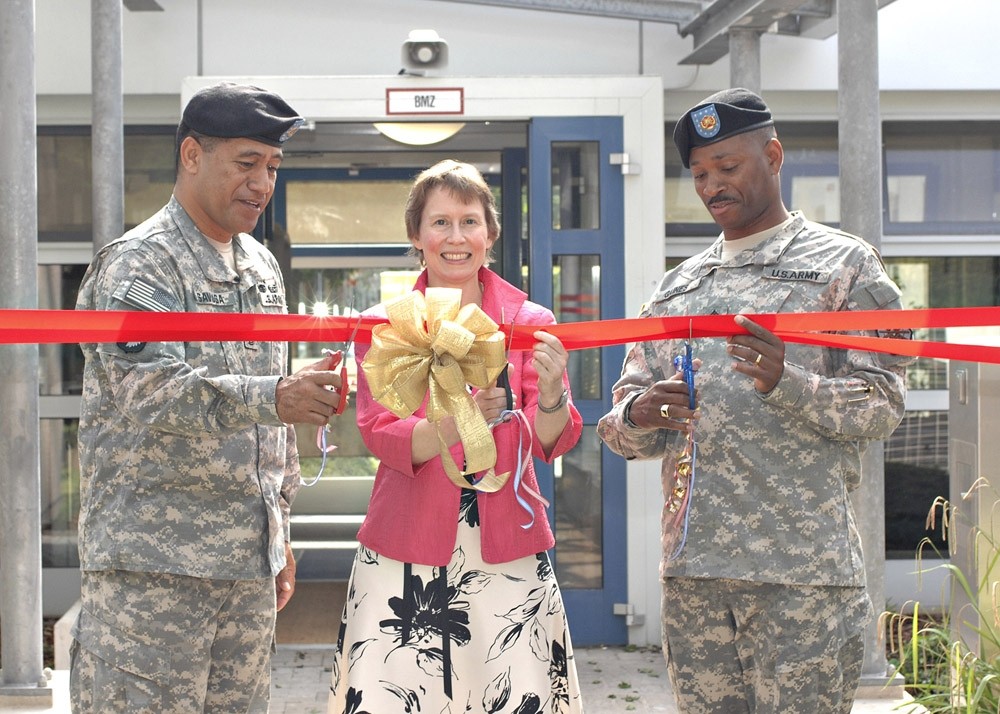
HEIDELBERG, Germany - "Wow," exclaimed medical librarian Jean Murphy on a recent visit to newly renovated building 3654, "this looks like a real library!"
And it is, as the European Regional Library and Support Center sports a new home here that does justice to its role as "the nucleus of the Europe Army Library Program," as Region Librarian Meg Tulloch puts it. With nearly 60,000 books and 175 periodicals, plus another 20,000 magazines and newspapers available online, the ERLSC acts as a main repository for all Europe.
Equivalent to a metropolitan library - but with branches scattered throughout 700 miles - ERLSC serves as the central point for a program stretching half a continent, providing technical, material and operational support, as well as offering a unique research collection that garrisons, from Belgium to Italy, can tap into via reference librarians.
"People see the physical space of the European Regional Library and identify with 'librariness' of it, but our reach goes far beyond that," Tulloch explained. "We ensure that our libraries have new books, CDs, audio-books, and DVDs on their shelves, and new computers for the public to use."
Overall, ERLSC supports 30 Installation Management Command-Europe Morale, Welfare and Recreation libraries with materials, computers, and a centralized online catalog and check-out system.
Tulloch oversees a 12-person staff whose duties include: administering central systems and library information technology; creating IMCOM-Europe MWR Library policies, operational guidance and technical advice; centrally purchasing library materials, online resources and replacement of program information technology equipment; and offering reference, interlibrary loan and document delivery services.
"It's a big job. We are on the phone and e-mailing with several different garrison libraries daily with library and technology issues," Tulloch said.
The reference library also plays a critical role Europe-wide, allowing servicemembers and their families to research practically any topic. Its vast resource collections are used to:
Aca,!Ac Assist people interested in history, science, international affairs, literature, art, business, computer science, math, medicine, languages and the social sciences
Aca,!Ac Act as a central repository for such materials, and lending them to all IMCOM-Europe MWR libraries
Aca,!Ac Help students of all ages and levels obtain scholarly materials
Aca,!Ac Support U.S.Army, Europe with informational and research needs
For example, visitor Renee Tanner browsed through the library's DVD section, stopping as she spotted Ken Burn's acclaimed PBS jazz collection next to a disc of blue guitarist B.B. King. "I'm working on a paper about American music and its cultural impact, and I was amazed to find the amount of diverse material here," she said.
Besides shelf after shelf and room after room of diverse reading material, the library also houses nearly 2,000 DVDs, more than 1,750 video and audio cassettes, 17 work stations for general Internet use, six computers for research and two online public catalog stations.
Indeed, walk down the video section and you'll see titles ranging from the "Story of Wine" to "Walk With the Dinosaurs." Head over to the DVD area and you find "25 Years of Saturday Night Live," along with classic and modern movies, popular PBS and BBC television series, and engaging documentaries.
In the reference section, there's row after row of thick books, ranging from "Record of World Events" to "Ancient Writers of Greece and Rome" to "The U.S. Army in World War II."
In fact, there is a separate military history room that holds a selection of current hardbacks shelved next to decades-old manuscripts. The collection includes some 250 unit histories, 7,000 pamphlets and original reports of operations dating back to the 1940s. Because of the compilation's value and importance, arrangements to review the material must be made before visiting the library, which is located adjacent to Campbell Barracks.
The ELRSC accommodates people looking for enlightenment and information, along with providing command-wide library support, Tulloch said.
And throughout the years it has grown from a command reference center to a central resource for the entire IMCOM-Europe MWR library program, even branching out to provide technical support for library computer and network issues, certainly not a role envisioned 59 years ago. It was then, in March 1948, that ERLSC was established and housed in one wing of Heidelberg's New University, in the Universitatsplatz area of the city's Old Town section.
But as the oldest Army library in Europe, ERLSC actually traces its roots back to port-Aux Poules, Algeria, where 2nd Lt. Rodney Kepley, in June 1943, oversaw a unit dayroom - simply known as The Library - with about 200 assorted fiction books, plus small sets of pocket books.
During World War II and afterwards, Kepley's library traveled throughout Italy and France, eventually moving from the French village of Vittel to Heidelberg with more than 6,000 books. A quote from the library's history states: "Packing and crating the books for the move to Heidelberg was accomplished with a minimum of difficulty as the entire headquarters staff considered the library an item of top priority."
As it remains so today.

Social Sharing